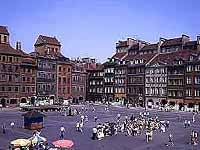 Warsaw OverviewAs the capital of Poland, Warsaw was one of the most beautiful
and sophisticated cities in central Europe until it was almost
totally destroyed during the Nazi occupation of World War II. The
end of the war saw most of the city reduced to rubble and ruins,
and the large swathes of the population had either been killed or
interred in Nazi concentration camps. The city underwent a major regeneration following the havoc of
destruction, and the buildings in the heart of the old city were
meticulously restored. Most of the historic Old Town was
painstakingly rebuilt from a pile of debris, restoring it to its
original 17th and 18th Century appearance. The charming Old Market
Square, the centre of the rebuilding process, is now a major World
Heritage Site attraction. Warsaw is divided into two distinct halves by the Vistula River,
with the Old Town, the modern city centre and most of the
attractions on the western side. The eastern side of the river is
comprised of uninteresting residential suburbs and business
districts. The post-war appearance of Warsaw is a modern urban
landscape of high-rise buildings, and the years of communist rule
have left an uninspiring architectural legacy of drab concrete
structures and uniform prefab-style housing. Dominating the skyline
is the city's major eyesore: the massive shape of the Palace of
Science and Culture, Stalin's bequest to Polish citizens. Lying in determined contrast to the concrete greyness are traces
of Poland's grand past, including castles and palaces, open
parklands, impressive churches and the restored streets of the
historic old centre. Signs of former political austerity have been
replaced by modern progression, with dreary state shops turned into
fashionable boutiques, and consumerism a growing trend. Although many people give scant regard to Warsaw as an appealing
tourist destination, it is still Poland's largest city and the
political, economic, scientific and cultural hub of the country. It
has many museums and historical monuments, galleries and historic
attractions, a variety of restaurants and open-air cafes, and an
energetic nightlife. With green open spaces and classical music
concerts, this modern bustling city is a far cry from the severe
communist-era images of post-war Warsaw. |